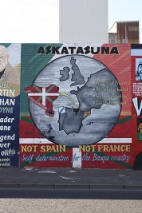
Frederick Douglass visited Belfast in 1845 and was both impressed by the lack of racial prejudice he was met with during his stay and felt connected to the struggles of the peasantry that he observed, though it is important to note that his experiences with race, “undoubtedly stemmed in large part from the fact that he was moving in the genteel, middle class Protestant milieu from whence Irish support for abolition stemmed” (Rolston, 446).
This mural was painted by Danny Devenney in 2006 and reads: “Inspired by two Irishmen to escape from slavery Frederick Douglass came to Ireland during the famine. Henceforth he championed the abolition of slavery, women’s rights and Irish Freedom. ‘Perhaps no class has carried prejudice against colour to a point more dangerous than have the Irish and yet no people have been more relentlessly oppressed on account of race and religion’- Frederick Douglass.”
Many groups that have fought imperialism looked to and were inspired by Ireland’s struggle, but particularly early on in the Irish republican movement (before the 1960’s) this support was not always reciprocated. Thus, while there were some abolitionists in Ireland, there were also many who rejected any attempts at fostering a brotherhood between the two causes: creating tension between, “the revolutionary whose emancipatory ideals are confined to his own nation, and […] the internationalist who recognizes the plight of others in that of his own nation” (Rolston, 452).
However, this mural was painted well after this period, and was created in the tradition of murals with an international focus—thus abolition, women’s rights, and Irish freedom can be placed right next to each other without any pushback and Douglass’s visit to Ireland can be interpreted through a far more singular lens.


